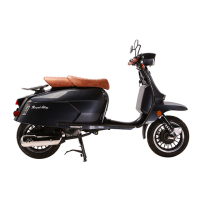
Do you have a question about the Royal Alloy Grand Tourer 150 and is the answer not in the manual?
| Displacement | 149.6 cc |
|---|---|
| Cooling System | Air-cooled |
| Transmission | Automatic CVT |
| Front Suspension | Telescopic fork |
| Front Brake | Disc |
| Seat Height | 770 mm |
| Tires Front | 110/70-12 |
| Tires Rear | 120/70-12 |
| Engine Type | Single cylinder, 4-stroke |
| Fuel System | EFI (Electronic Fuel Injection) |
| Fuel Capacity | 11 liters |
| Weight | 130 kg |
| Wheelbase | 1390 mm |
| Rear Suspension | Dual shock absorbers |
Welcome to Royal Alloy scooters and guidance on manual usage and safety symbols.
Explanation of manual symbols like Caution, Note, and Warning for user safety.
Disclosure of chemicals known to cause cancer/birth defects from vehicle operation.
Details on vehicle warranty and legal prohibition against altering noise control devices.
Importance of practice, traffic regulations, and initial safety measures before riding.
Advisories for riding in rain and recommendations for safety gear and checks.
Recommendations for safety clothing and warnings about high temperature components.
Prohibition of unit modifications that compromise riding safety.
Labelled diagram and identification of scooter parts on the right side view.
Labelled diagram and identification of scooter parts on the left side view.
Warning about the maximum payload capacity of the rear rack.
Information on where the engine and chassis serial numbers are stamped on the vehicle.
Explanation of various indicators on the scooter's instrument panel.
Operation of ignition switch, handlebar switches (beam, turn, horn).
Operation of starter button, throttle grip, brake levers, and emergency engine stop.
How to use the kick starter, main stand, side stand, and seat lock mechanism.
Procedure for opening and closing the fuel tank cap, including operational notice.
Guidelines and cautions for using the front luggage box.
Recommended fuel, engine oil (JASO MB 15W-40), and transmission oil (GL-4 85W-140).
Importance of the first 500 miles and recommended throttle operation limits.
Benefits of varying engine speed and allowing oil circulation before riding.
Details on the crucial first service for optimal engine life and performance.
Essential checks for steering, brakes, tyres, fuel, lights, horn, and engine oil.
Checking brake lever free play, resistance, and front brake anti-dive linkage.
Checking tyre pressure (29/32 psi) and ensuring sufficient fuel level.
Procedures for checking and topping up engine and transmission oil.
Verifying operation of lights, and inspecting mirrors and reflectors.
Detailed steps for starting the engine, covering cold and warm states.
Steps for mounting, checking surroundings, using indicators, and beginning to drive.
How to adjust speed using throttle and apply brakes effectively for stopping.
Advice for wet/wintery conditions, and safe parking with handlebar locking.
Explanation of periodic service intervals based on distance or time.
Maintenance for battery, spark plug gap, fuel hoses, and air filter cleaning.
Adjustments for engine idle speed and throttle cable slack.
Specifications for hydraulic brake fluid and guidance on tyre tread condition.
Location of the fuse, replacement guidelines, and general inspection points.
Steps to diagnose and resolve issues when the engine refuses to start.
Steps to diagnose and resolve engine stalling problems.
General guidelines for preparing the scooter for extended periods of non-use.
Procedures for fuel draining, battery storage, and protecting external parts.
Steps to recommission the scooter after a period of storage.
Technical details on model, dimensions, engine specs, performance, and fluids.
Specifications for tyres, brakes, lights, battery, fuse, horn, and noise levels.
How to report defects to NHTSA and disclaimer regarding manual updates and accuracy.